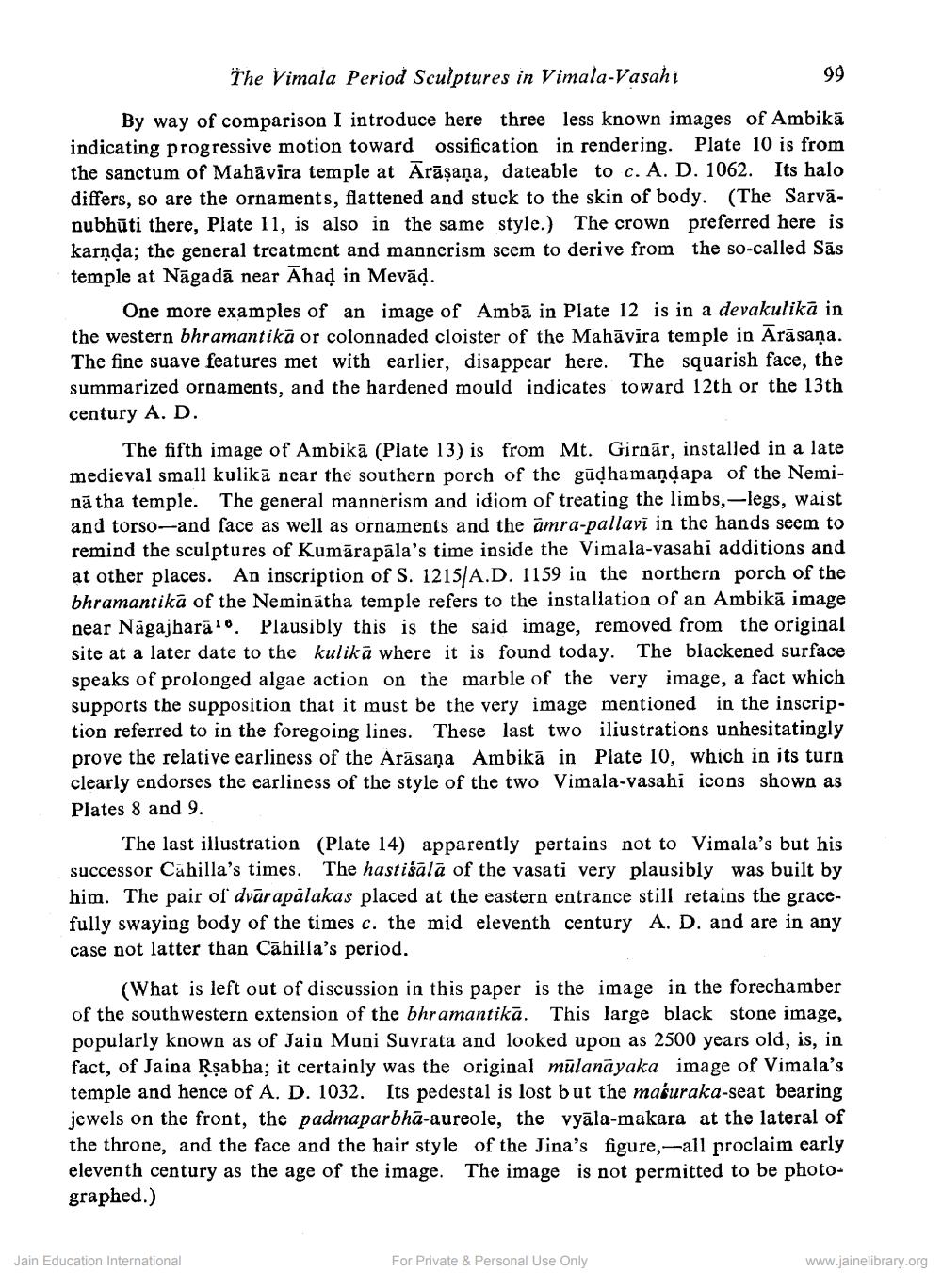Book Title: Vimala Period Sculptures in Vimal Vashi Author(s): M A Dhaky Publisher: Z_Aspect_of_Jainology_Part_2_Pundit_Bechardas_Doshi_012016.pdf View full book textPage 4
________________ The Vimala Period Sculptures in Vimala-Vasahi 99 By way of comparison I introduce here three less known images of Ambikā indicating progressive motion toward ossification in rendering. Plate 10 is from the sanctum of Mahāvira temple at Ārāsaņa, dateable to c. A. D. 1062. Its halo differs, so are the ornaments, flattened and stuck to the skin of body. (The Sarvānubhūti there, Plate 11, is also in the same style.) The crown preferred here is karnda; the general treatment and mannerism seem to derive from the so-called Sās temple at Nāgadā near Ahad in Mevād. One more examples of an image of Ambā in Plate 12 is in a devakulikā in the western bhramantikā or colonnaded cloister of the Mahāvira temple in Arāsaņa. The fine suave features met with earlier, disappear here. The squarish face, the summarized ornaments, and the hardened mould indicates toward 12th or the 13th century A. D. The fifth image of Ambikā (Plate 13) is from Mt. Girnar, installed in a late medieval small kulikā near the southern porch of the gūdhamaņqapa of the Nemină tha temple. The general mannerism and idiom of treating the limbs,-legs, waist and torso--and face as well as ornaments and the amra-pallavi in the hands seem to remind the sculptures of Kumārapāla's time inside the Vimala-vasahi additions and at other places. An inscription of S. 1215/A.D. 1159 in the northern porch of the bhramantika of the Neminātha temple refers to the installation of an Ambikā image near Nägajhara 6. Plausibly this is the said image, removed from the original site at a later date to the kulikā where it is found today. The blackened surface speaks of prolonged algae action on the marble of the very image, a fact which supports the supposition that it must be the very image mentioned in the inscription referred to in the foregoing lines. These last two iliustrations unhesitatingly prove the relative earliness of the Arāsana Ambikā in Plate 10, which in its turn clearly endorses the earliness of the style of the two Vimala-vasahi icons shown as Plates 8 and 9. The last illustration (Plate 14) apparently pertains not to Vimala's but his successor Cahilla's times. The hastiśālā of the vasati very plausibly was built by him. The pair of dvār apalakas placed at the eastern entrance still retains the gracefully swaying body of the times c. the mid eleventh century A. D. and are in any case not latter than Cāhilla's period. (What is left out of discussion in this paper is the image in the forechamber of the southwestern extension of the bhramantikā. This large black stone image, popularly known as of Jain Muni Suvrata and looked upon as 2500 years old, is, in fact, of Jaina Rşabha; it certainly was the original mūlanāyaka image of Vimala's temple and hence of A. D. 1032. Its pedestal is lost but the masuraka-seat bearing jewels on the front, the padmaparbhā-aureole, the vyāla-makara at the lateral of the throne, and the face and the hair style of the Jina's figure,-all proclaim early eleventh century as the age of the image. The image is not permitted to be photographed.) Jain Education International For Private & Personal Use Only www.jainelibrary.orgPage Navigation
1 2 3 4 5 6 7 8 9 10 11 12
